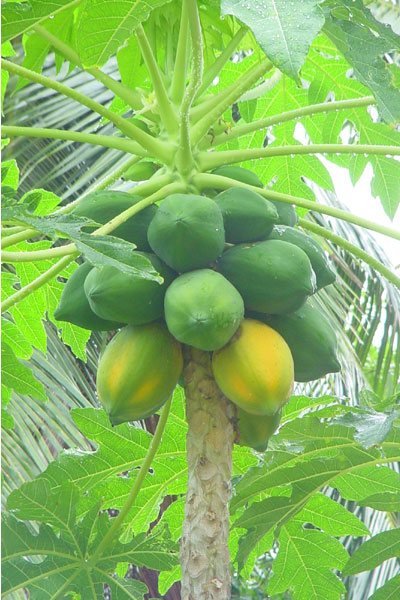

Health Benefits of Papaya
VITAMINS
o Vitamin A : 1,750 I.U
o Vitamin B : Thiamine 0.03 mg.
o Riboflavin : 0.04 mg.
o Niacin : 0.3 mg.
o Vitamin C : 56 mg.
o Also contains Vitamin E and K.
MINERALS
o Calcium : 20 mg.
o Iron : 0.3 mg.
o Phosphorus: 16 mg.
o Potassium : 470 mg.
FAT : 0.1 gm.
CAROHYDRATES : 10gm.
PROTEIN : 0.6gm.
CALORIES : 39
Heart disease: Papayas may be very helpful for the
prevention of atherosclerosis and diabetic heart disease.
Papayas are an excellent source of vitamin C as well as a
very good source of vitamin E and beta-carotene, three very powerful antioxidants.
These nutrients help prevent the oxidation of cholesterol. Only when
cholesterol becomes oxidised is it able to stick to and build up in blood
vessel walls, forming dangerous plaques that can eventually cause heart attacks or strokes.
High cholesterol: Papayas are also a very good source of fibre, which has been
shown to lower high cholesterol levels.
The folic acid found in papayas is needed for the conversion of a substance called
homocysteine into benign amino acids. If unconverted, homocysteine can directly
damage blood vessel walls and is considered a significant risk factor for a heart attackor stroke.
protection for colon cells from free radical damage to their DNA.
Increasing your intake of these nutrients by enjoying papaya is an especially good idea
for individuals at risk of colon cancer.
Inflammation: The enzymes contained in papaya have been shown to help lower inflammation and to improve healing from burns.
In addition, the antioxidant nutrients found in papaya are also very good at reducing inflammation.
This may explain why people with diseases that are worsened by inflammation, such as asthma,
osteoarthritis and rheumatoid arthritis, find that the severity of their condition is reduced
when they get more of these nutrients.
A July 2004 study indicates that vitamin C-rich foods, such as papaya, provide humans with
protection against inflammatory polyarthritis, a form of rheumatoid arthritis involving two or
more joints. The findings, presented in the Annals of the Rheumatic Diseases were drawn
from a study of more than 20,000 subjects who kept diet diaries and were arthritis-free when the study began.
Subjects who consumed the lowest amounts of vitamin C-rich foods were more than three
times more likely to develop arthritis than those who consumed the highest amounts.
Other benefits: The fibre found in papayas may also help with the symptoms of those suffering from irritable bowel syndrome.
In addition, vitamin C and vitamin A, which is made in the body from the beta-carotene in
papaya, are both needed for the proper function of a healthy immune system. Papaya
may therefore be a healthy fruit choice for preventing such illnesses asrecurrent ear infections, colds and flu.
The Ayurveda experts have regarded papain as a remedy for abdominal disorders.
It is a good medicine for dysentery, hyperacidity, dyspepsia and constipation.
Pimples are removed by rubbing the white pulp of raw papaya on the face.
It bringslustre to the face and removes wrinkles.
The ripe fruit is easily digestible and prevents constipation.
Case studies indicate that this food taken alone for two or three days has a highly
beneficial tonic effect upon the stomach and intestines.
The juice of the papaya aids in relieving infections of the colon and has a tendency
to break down pus and mucus reached by the juice.
May help prevent cancer in organs and glands with epithelial tissue (ripe papaya).
Papaya’s fiber is able to bind to cancer-causing toxins in the colon and keep
them away from the healthy colon cells. In addition, papaya’s folate, vitamin C,
beta-carotene, and vitamin E have each been associated with a reduced risk of colon cancer
Prevents nausea (includes morning sickness and motion sickness)
The seeds are antihelmintic, for expelling worms and they are given with honey.
Chew and swallow two teaspoonfuls of seeds after each principal meal (three times a day).

No comments:
Post a Comment